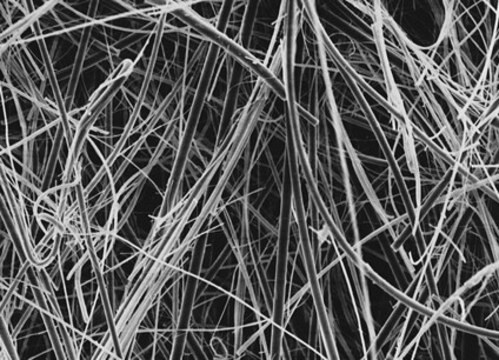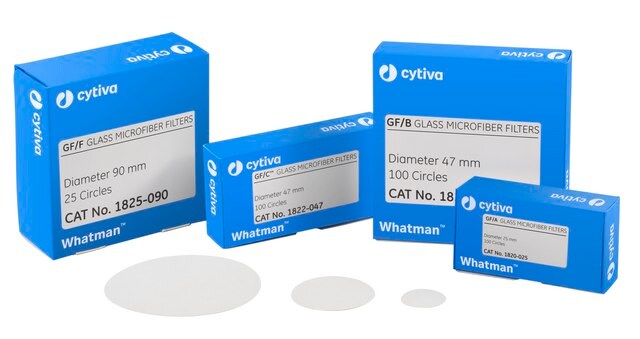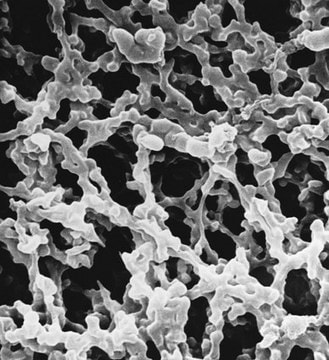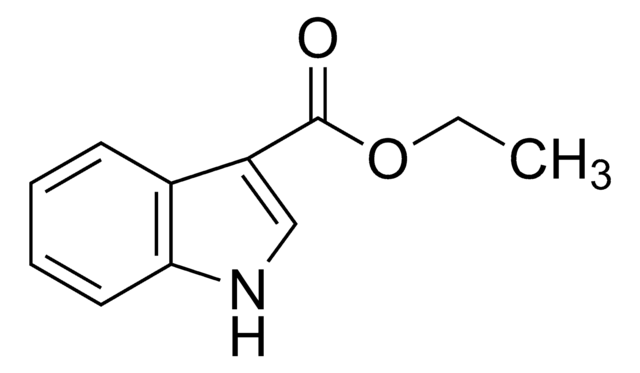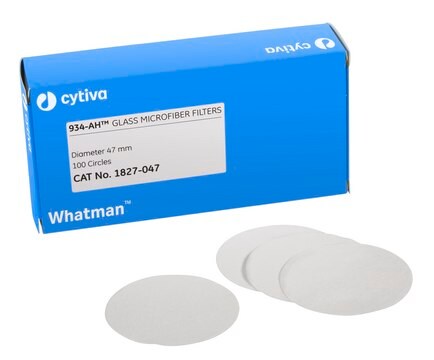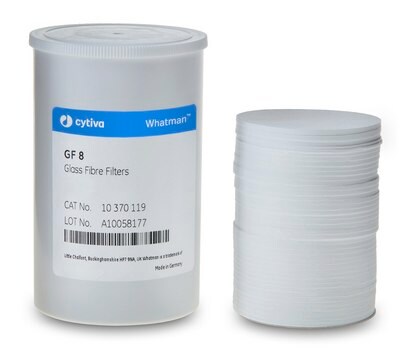AP4004700
Glass Fiber Membrane Filter, 0.7 μm Pore Size
Millipore, filter diam. 47 mm, hydrophilic, thickness 475 μm
Synonym(s):
Glass Fiber Filter without binder, Glass Fiber membrane filter, Glass Fiber membrane filter discs, Hydrophilic Glass Fiber membrane filter
About This Item
Recommended Products
material
glass fiber membrane
plain filter
white filter
Agency
suitable for EPA 1633
suitable for EPA OTM-45
suitable for ISO 21675 2019
description
0.7 µm pore size, hydrophilic glass fiber, 47 mm diameter
sterility
non-sterile
feature
hydrophilic
manufacturer/tradename
Millipore
parameter
>300 mL/min-cm2 water flow rate (at 27 in Hg)
550 °C max. temp.
diam.
47 mm
filter diam.
47 mm
thickness
475 μm
pore size
0.7 μm pore size
application(s)
PFAS testing
shipped in
ambient
Looking for similar products? Visit Product Comparison Guide
General description
Millipore fibrous disc filters are available in a wide range of flow rates and throughput capacities. Our Glass Fiber filters are available with or without binder resins and can be sterilized by EO, gamma, or autoclave (121 °C at 1 bar).
Glass Fiber Filters with Binder Resin:
Millipore filters with binder resin have superior wet strength and are excellent for qualitative analysis and prefiltration, especially for heavily contaminated liquids. They are also widely used for clarification of aqueous solutions.
Type AP15
•Lowest dirt-holding capacity
•Recommended prefilter for 0.2 to 0.6 µm filters
Type AP20
•Lower retention, higher dirt-holding capacity than AP15 filters
•Recommended prefilter for 0.8 to 8.0 µm filters
•Use upstream to protect type AP15 filters
Type AP25
•Added thickness yields same retention and greater dirt-holding capacity as AP20
•Recommended prefilter for 0.9 to 8 µm filters, especially for proteinaceous and heavily contaminated liquids
•Use upstream to protect type AP15 filters
Glass Fiber Filters without Binder Resin:
The filters without binder resin retain their structural integrity without weight loss when heated up to 500 °C and can therefore be used in gravimetric analysis as well as for the filtration of hot gases.
Type APFA
•Retains fine particles with good efficiency, even at high flow rates
•Recommended for monitoring wastewater and collecting suspended particles in gases (e.g., fumes from chimneys)
•Use in biochemical applications (e.g., collection of cells and filtration of protein or nucleic acid precipitates)
Type APFB
•Higher mechanical strength when wet and greater loading capacity than type APFA filters
•Use for liquid clarification, quantification of solids in suspensions of fine particles, and scintillation counting
Type APFC
•Greater retention, especially for fine particulate and microorganism removal than type APFA filters
•Use for determining total suspended solids in drinking water
•Use for filtering proteins or nucleic acid TCA precipitates and for collecting cells and microorganisms
Type APFD
•Thick filter with high flow and low retention
•Use for clarifying suspensions containing particulates greater than 1.0 µm
Type APFF
•Use for filtering extremely fine precipitates such as protein, nucleic acids, or serum precipitates
•Recommended for USEPA method 1311 for TCLP analysis
Type AP40
•Recommended for Standard Methods Total Suspended Solids 2540D
•Recommended for USEPA method 1311 for TCLP analysis
•Maintains structural integrity without weight loss when ignited to 550 °C (1022 °F) after sample filtration
•Recommended for determining volatile suspended matter in wastewater and industrial effluents
Application
- Total Suspended Solids 2540D
- EPA method 1311 for TCLP analysis
- Determining volatile suspended matter in wastewater and industrial effluents
- Stack Testing for PFAS via OTM-45
also commonly purchased with this product
Storage Class Code
11 - Combustible Solids
Certificates of Analysis (COA)
Search for Certificates of Analysis (COA) by entering the products Lot/Batch Number. Lot and Batch Numbers can be found on a product’s label following the words ‘Lot’ or ‘Batch’.
Already Own This Product?
Find documentation for the products that you have recently purchased in the Document Library.
Customers Also Viewed
Articles
Data and recommended filtration products for OTM-45 Method for Air Monitoring of PFAS Compounds.
This page provides tables that list the products used in promulgated methods for Per- and polyfluoroalkyl substances (PFAS) analysis, organized by method and step for easy reference. As new methods are released, this page will be updated.
Related Content
FAS, or 'forever chemicals,' persist in the environment and pose risks to human health. Discover our environmental monitoring tools for PFAS quantification, aiding researchers, regulators, and labs in testing for PFAS.
Our team of scientists has experience in all areas of research including Life Science, Material Science, Chemical Synthesis, Chromatography, Analytical and many others.
Contact Technical Service